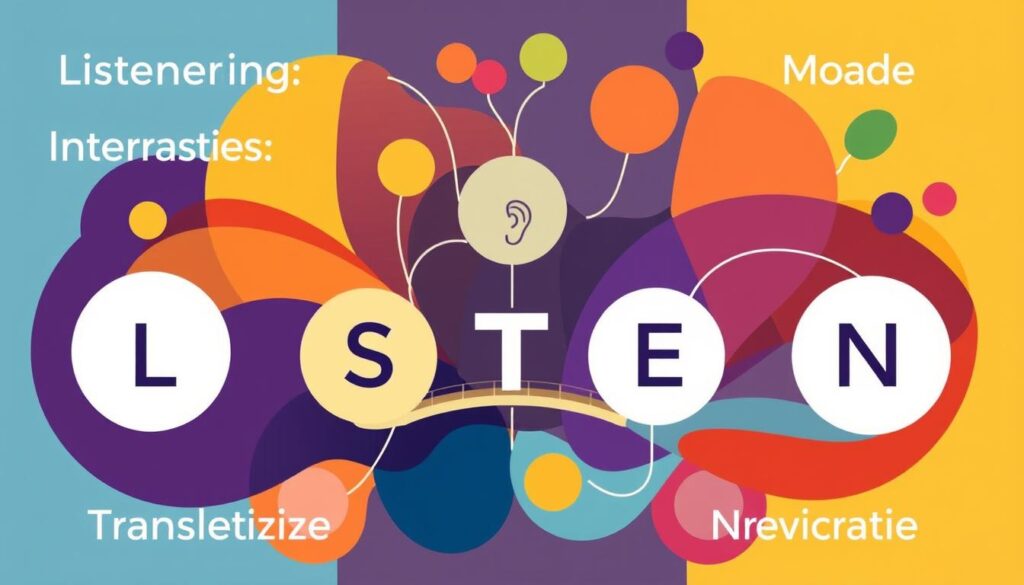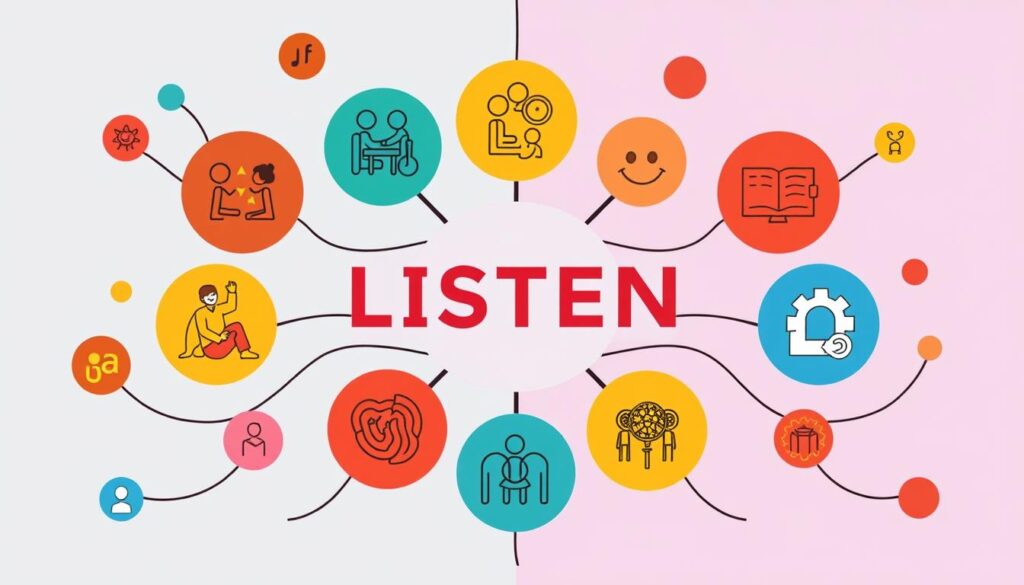Have you ever felt a sting from feedback or found it inspiring? In today’s diverse workplaces, how we give and receive feedback matters a lot. With 89% of white-collar workers on global teams, cultural competence is key1.
Effective communication across cultures is vital for team success. But, only 42% of managers feel ready to talk about race and equality at work1. This shows how important cultural sensitivity is, especially in feedback.
Inclusive leadership and cultural competence are vital skills today. They help us communicate better, work more efficiently, and make a workplace where everyone feels valued.
Key Takeaways
- Cultural sensitivity is crucial for effective communication in diverse teams
- Most white-collar employees work in global teams, emphasizing the need for cultural competence
- Less than half of managers feel prepared to address diversity and inclusion issues
- Inclusive leadership skills are essential for navigating modern workplaces
- Cultural sensitivity in review responses can improve team performance and collaboration
- Training and awareness programs can enhance cultural competence in the workplace
Understanding Cultural Sensitivity in the Workplace
In today’s diverse workplaces, cultural sensitivity is key. It means understanding and valuing differences without judging them. This is vital for creating places where everyone feels welcome and safe2. It also helps us communicate better across different cultures.
The U.S. is getting more diverse, making it crucial to talk better with people from various backgrounds2. This change shows how important it is to grow our cultural smarts at work.
Language can really affect how we talk to each other, especially in places where many cultures meet3. To help, companies should offer more than just translation services. They should work on making everyone feel respected and understood, even if English isn’t their first language2.
Getting better at understanding different cultures is a process. It starts with not knowing much and ends with valuing everyone’s input2. This journey has six stages, moving from being unaware to truly getting along with all cultures3.
“Diversity is being invited to the party; inclusion is being asked to dance.” – Verna Myers
Being sensitive to culture at work has big benefits. Studies show that teams with more diversity do better, reaching new markets and growing more4. By being more culturally aware, we make places where everyone feels safe to share their thoughts. This leads to better work and success4.
Key Components of Cultural Sensitivity in Review Responses
Cultural sensitivity is key in giving good review responses. We must grasp its main parts to make our workplaces more welcoming. At the heart of culturally sensitive feedback are empathy and active listening.
Empathy means getting different viewpoints and seeing cultural details. It’s about imagining how others feel and valuing their stories. This skill is vital in healthcare, where understanding cultures can greatly improve patient care5.

Active listening is vital in giving feedback. It means fully focusing on others and understanding their words without judging. This skill helps close communication gaps and builds respect in diverse teams.
“Cultural competence, cultural humility, and patient-centered care are essential components for a healthcare workforce sensitive to patient diversity, individual choice, and doctor-patient connection.”
To make review responses more culturally sensitive, we should focus on these key points:
- Understanding different communication styles
- Recognizing non-verbal cues
- Adapting language to cultural contexts
- Showing respect for diverse beliefs and values
In nursing education, teaching cultural competence helps prepare students for the challenges of working with different cultures6. This method can be used in many workplaces, making feedback better overall.
| Component | Description | Impact on Review Responses |
|---|---|---|
| Empathy | Understanding others’ emotions and perspectives | Creates a supportive environment for honest feedback |
| Active Listening | Fully concentrating on the speaker without interruption | Ensures all feedback is heard and understood |
| Cultural Awareness | Recognizing cultural differences and their impact | Prevents misunderstandings in diverse teams |
| Adaptive Communication | Adjusting communication style to suit different cultures | Improves clarity and effectiveness of feedback |
By using these elements, we can make feedback more inclusive and effective. It will respect cultural differences and help everyone grow in diverse workplaces.
Cultural Sensitivity in Review Responses: Best Practices
We live in a world full of different cultures. By 2044, no single group will be the majority in the U.S., with non-White populations expected to hit 56% by 20607. This change shows how important it is to be culturally sensitive at work.
To make communication more inclusive, we suggest using the LISTEN framework. This method boosts cultural smarts and encourages open talks. Here’s how it works:
- Learn through active listening
- Inquire with clarification
- Synthesize with self-awareness
- Translate through adaptation
- Empathize with perspective-taking
- Navigate with reflective listening
Using LISTEN and the “Listen, Thank, Clarify” method makes getting feedback better. This helps tackle cultural differences well. Research shows that therapists who are more culturally competent also build stronger relationships and show more empathy8.

Companies can use the Cultural Competence Model. It means valuing diversity, checking cultural awareness, understanding differences, making cultural knowledge a part of the workplace, and adjusting to diversity9. These steps make the workplace more welcoming for everyone.
“Cultural competency is not just about understanding differences; it’s about creating an environment where everyone feels valued and heard.”
By following these best practices, we can connect cultures and create a truly welcoming workplace. Remember, being culturally sensitive in reviews is not just polite. It’s key for good communication in our diverse world.
Overcoming Challenges in Culturally Sensitive Feedback
Cultural bias and communication barriers often make giving feedback hard in diverse workplaces. A 2019 survey showed that 94% of employees said good feedback helped them do better. But, with more diversity, giving feedback right can be tricky10.
To beat these hurdles, we need to be humble and adjust how we talk to each other. We should understand that different cultures, genders, and ages want feedback in their own way10.

Using strategies like matching our words with what people expect and letting them take charge can help close the cultural gap in feedback10. Training on cultural sensitivity makes teams better at working together, creating a place of respect and understanding11.
“Radical candor,” a concept by Kim Scott, a former Google executive, shows how direct feedback is better than being overly empathetic.
Working with community leaders and offering translation helps everyone get the same info, which is key for solving conflicts in diverse teams11. By tackling biases and making sure everyone feels safe to speak up, we can build trust and fair communication across cultures.
| Challenge | Solution |
|---|---|
| Cultural bias | Cultural sensitivity training |
| Communication barriers | Translation services |
| Misinterpretation of feedback | Align with recipient norms |
| Lack of trust | Create safe spaces for dialogue |
Implementing the LISTEN Framework for Culturally Intelligent Communication

We live in a world full of different cultures. Being able to communicate well is crucial for success. The LISTEN framework is a great way to improve cultural understanding in teams. It helps us work well together and give feedback that everyone can understand12.
LISTEN means Learn, Inquire, Synthesize, Translate, Empathize, and Navigate. By using these steps, we can get better at adapting to different cultures. This makes our workplace more welcoming for everyone12.
Let’s look at each step:
- Learn: Learn about different cultures and how people communicate
- Inquire: Ask questions that are sensitive to different cultures
- Synthesize: Think about how our own biases affect us
- Translate: Make feedback that works for everyone
- Empathize: Try to see things from other people’s point of view
- Navigate: Handle power issues when talking across cultures
Using this framework helps us communicate better and work together more smoothly. It’s really important in the U.S., where over 25% of people are new to the country13. By using LISTEN, we can make our workplaces welcoming to everyone.
Cultural intelligence means working well with people from different cultures. It takes active listening, empathy, and being open to change. By getting better at these skills, we can build strong teams. This helps us succeed in our global world12.
Conclusion
Cultural sensitivity is key in today’s diverse workplaces. It helps with better communication and team success. With the Hispanic population in the U.S. set to hit 25 percent by 205014, this skill is more important than ever.
Our exploration of cultural sensitivity shows its big impact. By 2043, the U.S. will be mostly minority, making a diverse workplace crucial14. This change shows why tools like LISTEN are vital for feedback and improving cultural awareness.
Getting better at cultural sensitivity isn’t easy. In 2013, the FBI found nearly 6,000 hate crimes in the U.S., with 60 percent linked to race or ethnicity14. These numbers remind us why we must keep improving our cultural skills. By doing so, we make workplaces where everyone can do well and help us all succeed.
FAQ
What is cultural sensitivity in the workplace?
Why is cultural sensitivity important in review responses?
What are the key components of cultural sensitivity in review responses?
What are some best practices for cultural sensitivity in review responses?
What challenges might arise in culturally sensitive feedback?
How can the LISTEN framework be implemented for culturally intelligent communication?
Why is continuous improvement in cultural competence essential?
Source Links
- Fostering Cross-Cultural Understanding in a Diverse Workforce – https://primalogik.com/blog/fostering-cross-cultural-understanding-in-a-diverse-workforce/
- Understanding Cultural Awareness, Sensitivity & Competence – https://www.helloglobo.com/blog/understanding-cultural-awareness-sensitivity-competence
- Cultural Sensitivity in the Workplace – https://extension.psu.edu/cultural-sensitivity-in-the-workplace
- Managing Cultural Sensitivity In A Diverse Workplace – https://convergeinternational.com.au/resources/managing-cultural-sensitivity-in-a-diverse-workplace/
- Practicing Cultural Competence and Cultural Humility in the Care of Diverse Patients – https://www.ncbi.nlm.nih.gov/pmc/articles/PMC7011228/
- Cultural Competence and Cultural Sensitivity Education in University Nursing Courses. A Scoping Review – https://www.ncbi.nlm.nih.gov/pmc/articles/PMC8514292/
- Critical Conversations: Cultural Awareness, Sensitivity, and Competency – https://clsjournal.ascls.org/content/30/1/34
- The Case for Cultural Competency in Psychotherapeutic Interventions – https://www.ncbi.nlm.nih.gov/pmc/articles/PMC2793275/
- Chapter 27. Working Together for Racial Justice and Inclusion | Section 7. Building Culturally Competent Organizations | Main Section – https://ctb.ku.edu/en/table-of-contents/culture/cultural-competence/culturally-competent-organizations/main
- When Diversity Meets Feedback – https://hbr.org/2023/09/when-diversity-meets-feedback
- Culturally Sensitive Call Response – https://www.firehouse.com/community-risk/community-risk-reduction/article/53067392/cultural-sensitivity-integral-to-fire-departments-optimal-community-service
- How to Receive Feedback (with Cultural Intelligence) – Engineer Inclusion – https://engineerinclusion.com/how-to-receive-feedback-with-cultural-intelligence/
- On the Importance of Listening and Intercultural Communication for Actions against Racism – https://www.ncbi.nlm.nih.gov/pmc/articles/PMC9744981/
- An Important Skill Set for the 21st Century – https://extensionpublications.unl.edu/assets/html/g1375/build/g1375.htm

